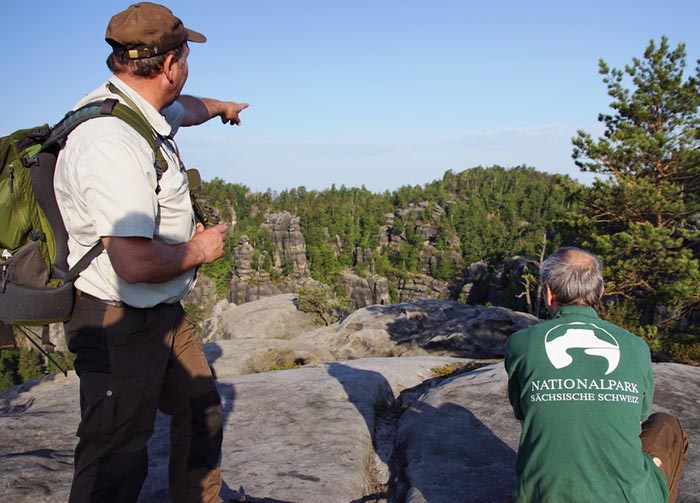National parks – islands in a desert?

A nature conservation ranger of the Saxon Switzerland National Park, Germany, shows his colleague a forest area where he had discovered an illegal fireplace.
Credit: Hanspeter Mayr, Saxon Switzerland National Park
Effectiveness of biodiversity conservation in national parks is associated with socioeconomic conditions.
Despite commendable conservation efforts and investments by governments, NGOs and international as well as national conservation agencies, biodiversity continues to decline across the globe. One of the key strategies to halt biodiversity decline is the establishment of protected areas like national parks, which are supposed to provide favourable conditions for biodiversity to remain stable.
Species declines are strongly associated with Human Development Index
An international research team led by iDiv, MPI-EVA, and the University of Bonn, in collaboration with the UFZ, Leipzig University, the Friedrich Schiller University Jena and many other institutions has now investigated the biodiversity conservation effectiveness of 114 national parks in 25 countries in Africa and Europe on the basis of changes in abundances of 464 mammal and bird species. Within the surveyed ten-year period from 2007 to 2017, they found that the effectiveness of the 66 African and 48 European parks strongly depended on the respective local and national economic and societal conditions – which are reflected in the Human Development Index (HDI). A likely explanation is that resource demand from national parks is higher and less regulated when the HDI is low, making the parks less effective. The parks located in countries with highest HDI values showed average declines in species abundance of about 10% compared to more than 25% in parks located in countries with lowest HDI.
National parks do not guarantee 100% protection
“But we also found that seemingly effective national parks embedded in favourable socioeconomic context (such as high HDI) are not necessarily a generic solution for ideal national park management”, says lead author Dr Tsegaye Gatiso, researcher at the University of Bonn and iDiv. “Finally, no socioeconomic conditions and no set of currently implemented conservation measures can guarantee the elimination of threats to biodiversity. Species may still decline in the same national park under less favourable conditions because protected areas are an inseparable part of a dynamic, complex social-ecological system.”
Better design of national parks network needed
The researchers, therefore, conclude that a marginal gap to fully effective national parks remains. A critical need is an improved design of the national park network and associated management to reduce threats and make it ecologically functional. Concerted actions that include expanding the national park network, establishing corridors between protected areas to facilitate the dispersal of species between them, and, very importantly, improving conditions for biodiversity outside national parks are the most critical elements to halt biodiversity loss.
“Many national parks have become ‘islands in a desert of industrial agriculture, forestry and infrastructure’. The poor ecological conditions outside national parks reduce the species’ abundance. After all, they do not orient their distribution areas to national park boundaries set by humans. If they are then exposed to a variety of negative living conditions outside the parks, this also affects their abundance inside the parks,” adds the study’s senior author, Dr Hjalmar Kühl, a scientist at iDiv and MPI-EVA. “It is therefore important that the ecological conditions outside the parks are significantly improved. Protected areas, and especially national parks, are sensors for the state of our planet’s biodiversity. The lack of effectiveness of observed parks must be taken very seriously, and we must make great efforts to significantly improve the network of protected areas in terms of its ecological functionality.”
The study was funded by the German Center for Integrative Biodiversity Research (iDiv) (DFG FZT 118, 202548816; T.T.G. and H.S.K.) and the Robert Bosch Foundation (grant number 32.5.8043.0016.0; H.S.K.).
Journal: Nature Sustainability
DOI: 10.1038/s41893-022-00932-6
Method of Research: Data/statistical analysis
Subject of Research: Animals
Article Title: Gatiso, T. T., Kulik, L., Bachmann, M., Bonn, A., Bösch, L., Eirdosh, D., Freytag, A., Hanisch, S., Heurich, M., Sop, T., Wesche, K., Winter, M., Kühl, H. S. (2022). Effectiveness of protected areas influenced by socio-economic context.
Article Publication Date: 15-Aug-2022
Media Contact
Volker Hahn
German Centre for Integrative Biodiversity Research (iDiv) Halle-Jena-Leipzig
volker.hahn@idiv.de
Office: 49-341-973-3154
Original Source
Media Contact
All latest news from the category: Ecology, The Environment and Conservation
This complex theme deals primarily with interactions between organisms and the environmental factors that impact them, but to a greater extent between individual inanimate environmental factors.
innovations-report offers informative reports and articles on topics such as climate protection, landscape conservation, ecological systems, wildlife and nature parks and ecosystem efficiency and balance.
Newest articles

First-of-its-kind study uses remote sensing to monitor plastic debris in rivers and lakes
Remote sensing creates a cost-effective solution to monitoring plastic pollution. A first-of-its-kind study from researchers at the University of Minnesota Twin Cities shows how remote sensing can help monitor and…

Laser-based artificial neuron mimics nerve cell functions at lightning speed
With a processing speed a billion times faster than nature, chip-based laser neuron could help advance AI tasks such as pattern recognition and sequence prediction. Researchers have developed a laser-based…

Optimising the processing of plastic waste
Just one look in the yellow bin reveals a colourful jumble of different types of plastic. However, the purer and more uniform plastic waste is, the easier it is to…



